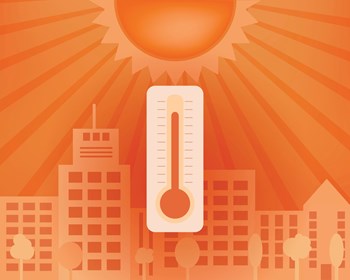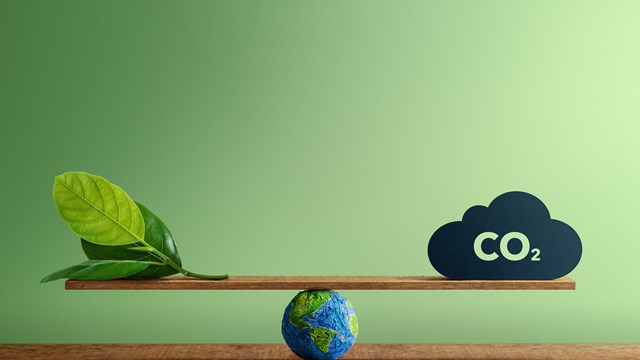
The reality of climate change is upon us. Weather patterns have changed, and seasons have been altered. We experience more intense heat, more frequent, destructive storms, wide-ranging wildfires, and more destructive cold. Tornadoes—the spawn of conflicting hot and cold air masses—touch down in places they were once almost unheard of. What was scientific prognostication only a few years ago has become reality. It’s also a reality that most of the structures that house our homes—particularly high-rise multifamily buildings—were not designed for these types of changing climate events. While that’s a chilling thought, today’s communities have no choice but to deal with that reality, as well as plan for what may be ahead.
The New Reality
Perhaps the two most pressing and dramatic ramifications of climate change currently facing our communities are the rise in sea level and the increasing frequency and severity of storms and other weather events. More concerningly, these two events often overlap, causing even greater peril. The worry is particularly severe for communities built along our coasts and shores—including along the shore of Lake Michigan.
“The real impact in the Midwest has involved Lake Michigan,” says Phillip Mahan, owner and president of Bloomingdale, Illinois-based engineering firm Structural Technologies. In recent years, he says, “The lake’s water level has risen by two feet due to increased storm intensity and runoff. The result has been significant erosion of the shoreline, especially around Chicago and into Indiana and Michigan—whole sections of land are shearing off and falling into the lake. The trend and the damage are significant. In an effort to stave off the damage, pilings have been put in or reinforced. Seawalls—including gigantic stones to act as breakwalls to protect building foundations—have been built, but we do have potential building collapse problems.”
“The biggest issue is along our waterfronts,” says Kevin Keating, an architect with Selldorf Architects, a global architectural firm, echoing Mahan’s analysis. For oceanfront communities in New York, New Jersey, Florida, and New England, for instance, rising sea level is the biggest issue. Combine that with bigger storms up and down the East Coast, and you must ask the question of how we will fortify the properties against the combination of these two factors.
In Chicago’s case, Mahan explains, “[The city] is built on silt and backfill as far west as Michigan Avenue. The lake is already two feet higher, and that backfill is saturated. Lakeshore Drive is at risk. It’s an iconic address, and owners are very concerned about the stabilization of their footings because of the rising water table. The problem we face is destabilized soils. Building pilings are on bedrock, but the steel is exposed to water and can corrode. Corrosion of steel within pilings and rebar is the major issue.”
On a more global, macro level, “Hotter is hotter, and colder is colder,” says Howard Zimmerman, owner and founder of New York-based consultancy Howard Zimmerman Architects & Engineers. He explains that these new extremes in temperature add stress to our building systems, reducing their useful life and requiring more maintenance and earlier replacement.
Peter Varsalona, vice president and principal of New York-based RAND Engineering, brings up yet another concern: with worsening extremes of hot and cold, existing HVAC systems require more energy to maintain comfortable (or just livable) interior temperatures. This increased energy usage in turn exacerbates the original problem of human-made carbon emissions. So not only does climate change cause more extreme conditions, but the extreme conditions it causes require still more energy to mediate, which in turn worsens the problem...you see where this is going.
How Much Worse?
The reality is that the situation is likely to get worse before it gets better. Years of inaction and over-politicization of the issue have given human industry the upper hand when it comes to impact on the planet. The United Nations Intergovernmental Panel on Climate Change (IPCC) released its most recent report on the issue on August 9, 2021. Among its sobering findings was that averaged over the next 20 years, global temperature is expected to reach or exceed 1.5°C of warming—a rubicon of sorts that climate scientists say will result in increasing heat waves, longer warm seasons, and shorter cold seasons. According to the press release accompanying the report’s publication, “Unless there are immediate, rapid, and large-scale reductions in greenhouse gas emissions, limiting warming to close to 1.5°C or even 2°C will be beyond reach”—and once that line is crossed, many of the more dire consequences of a quickly heating planet will be unavoidable.
“We don’t know how fast it will worsen,” says Mahan. “Lake levels are expected to continue to rise. In the past we built with no ability to control runoff into lakes. Within 10 years, we may have a major catastrophe on our hands. Mitigation should have started a decade ago. We always had a lake effect on our weather, but now those numbers are bigger, and we’re getting storms and tornadoes like we have never seen before. What we need to do immediately is reduce our carbon footprint, which is causing a microclimate within the city. We need green roofs and solar-reflecting ‘white roof’ systems to reduce heat gain. Another big factor is the increase in glass buildings that don’t absorb heat but rather reflect the solar radiation back into the surrounding microclimate, negating other mitigation efforts. That reflective heat melted a car in California—and too many glass façades are reflecting heat back and forth and driving the heat index up in Chicago as well.”
Zimmerman observes that an intrinsic problem in dealing with the impending effects of climate change in our communities is the very structure by which our communities govern themselves. “The problem is that with most condo and co-op communities, the boards are composed of volunteers, and in some cases, those serving on boards have term limits. Planning of this kind is looking down the road 10 to 15 years —and no board wants to assess neighbors today for monies the building or HOA will need 15 years from now. The process is too short-sighted right now.”
“And,” adds Keating, “no one predicts these things. You don’t know what you don’t know. In many cases we react to what’s out there historically—but that’s a reaction to something that’s already happened. We are now talking about things that haven’t happened before—and there’s little political will to react to future problems. We tend to only react to what we’ve seen.” Based on the UN IPCC’s projections however, it’s becoming obvious that even if we haven’t yet seen what’s coming, the picture is getting clearer—and it isn’t pretty.
Countermeasures
All of this begs the question of what can we realistically do to counter the troubling trends that are clearly coming. In the context of multifamily co-ops, condos, and HOAs, most of the answers fall into three broad categories: floodplain management, energy efficiency, and appropriate capital improvement planning.
According to Mahan, regular inspections and evaluations of building systems are needed as well. Among other things, these assessments should look for structural changes like new cracks in walls, or anything that’s moving or sagging. “The thing is that we are seeing this rising water table and heavier rains and melts,” he explains. “The footings are moving and there are big cracks appearing. We have to evaluate whether the building is at risk. Every potentially affected property needs ongoing evaluation, and must be prepared to address any issues immediately. If you wait 15 years it’s not recoverable—as was demonstrated through the tragedy at [Champlain Towers condo] in Surfside, Florida. Boards must be proactive. The most important step to take is regular monitoring of the physical plant and structure.”
Another major concern is reducing the environmental impact of residential buildings. Many cities are enacting laws mandating the reduction of individual carbon footprints through more efficient energy use. “Ironically, rising temperatures are increasing energy use,” says Varsalona. “Sadly, the impact is that you use more energy to combat the changes, which perpetuates the cycle. For example, steam-generated systems need more electricity—so we must come up with ways to update old systems and make them more efficient. We must start planning and retooling now, not only to achieve our climate goals, but to also not be penalized by the new laws.” Retreating from fossil fuels to more sustainable, renewable sources like solar energy is what’s needed —but it’s certainly not easy.
In terms of maintaining and preparing our buildings for worsening conditions, the pros say it’s critical to put capital improvement plans in effect now. Zimmerman stresses that circumstances have changed. “We might not see the effect in the short term, but over the long term, driving rain, hotter heat, and colder cold has a corrosive effect on all mechanical systems. We will see it in the deterioration of roofs, facades, and infrastructure happening that much sooner. We might have gotten 30 years from a roof before. Now we will get 20 or 25 years. It’s a harsher environment—and that has a very real effect on the built environment—again reinforcing how critical it is for communities to have an appropriate capital reserve plan in place.
Practical Applications
Edwin Suarez, president of New York-based Jomavi Contracting, observes that changes in approach are already underway. “In today’s construction, we are very mindful of climate change,” he says. “Everything from paint, to compound, to insulation and other materials have changed to fulfill a more eco-friendly green standard. Green building materials with low—or even no—embodied carbon are on the rise. These materials produce little to no carbon or other greenhouse gases, and are overall environmentally more beneficial. Many projects are now one hundred percent green. Architects are really stepping it up as well, in both how they plan a job and in adhering to new building requirements. They are taking climate change seriously.”
Co-op and condominium boards must also consider the future well-being of their physical plant. “There should be some kind of best business practice, like guidelines for what kind of reserves must be maintained,” says Zimmerman. “Required capital funds of a certain percentage of value of property for instance, so that money is available for major capital expenditures. Boards should hire architects and engineers to explore their vulnerabilities—and as we learned from the Surfside condo collapse in Florida, reserve funds will become more and more critical. No board president wants to be faced with a report that says the property needs millions of dollars of work and they have $100 in the reserve account.”
“The timeframe to make your plans is now,” Keating stresses. “Don’t wait. Insurance is getting more and more complicated. Insurance companies always look to avoid risk, so they may refuse to insure some projects or buildings. The more storms, wildfires, and so forth we have, the more insurance premiums will go up—and they [may] reach a threshold where insurers feel it’s not worth the risk. There will be fewer and fewer companies offering protection.”
Varsalona concurs. “You’ve got to do it now,” he says. “If you don’t start now, you will be caught late.”
Climate change is no longer an abstract concept to be debated based on what side of the political divide we find ourselves on. It’s real, and according to both the science and the practical advice of professionals working in the field, it’s past time to start acting, rather than reacting. At this point, an ounce of prevention is worth way more than a pound of cure. Start mitigating now.
A J Sidransky is a staff writer/reporter for CooperatorNews, and the author of several published novels.









Leave a Comment